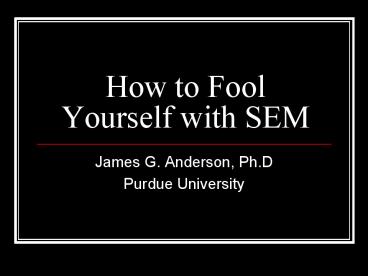How to Fool Yourself with SEM - PowerPoint PPT Presentation
1 / 12
Title:
How to Fool Yourself with SEM
Description:
Improper Care and Feeding: Data. 10. Don't check the accuracy of data input ... Look only at indices of overall fit and ignore other types of fit information. ... – PowerPoint PPT presentation
Number of Views:68
Avg rating:3.0/5.0
Title: How to Fool Yourself with SEM
1
How to Fool Yourself with SEM
- James G. Anderson, Ph.D
- Purdue University
2
Tripping at the Starting Line Specification
- Specify the model after the data are collected
rather than before. - Omit causes that are correlated with other
variables in a structural model. - Fail to have sufficient numbers of indicator
latent variables. - Use psychometrically inadequate measures.
3
Tripping at the Starting Line Specification (2)
- Fail to give careful consideration to the
question of directionality. - Specify feedback effects in structural models as
a way to mask uncertainty about directionality. - Overfit the model (e.g., forget the goal of
parsimony.
4
Tripping at the Starting Line Specification (3)
- Add disturbance or measurement error correlations
without substantive reason. - Specify that indicators load on more than one
factor without substantive reason.
5
Improper Care and Feeding Data
- 10. Dont check the accuracy of data input or
coding. - Ignore whether the pattern of data loss is random
or systematic. - Fail to examine distributional characteristics.
- Dont screen for outliers.
- Assume that all relations are linear.
6
Checking Critical Judgment at the Door Analysis
and Re-specification
- Re-specify a model based entirely upon
statistical criteria. - Fail to check the accuracy of your programming.
- Analyze a correlation matrix when it is
inappropriate. - Analyze variables so highly correlated that the
solution is unstable.
7
Checking Critical Judgment at the Door Analysis
and Re-specification (2)
- Estimate a very complex model with a small
sample. - Set scales for latent variables inappropriately.
- Ignore the problem of starting values or provide
grossly inaccurate ones. - When identification status is uncertain, fail to
conduct tests of solution uniqueness.
8
Checking Critical Judgment at the Door Analysis
and Re-specification (3)
- 23.Fail to recognize empirical under-identificatio
n. - 24. Fail to separately evaluate the measurement
and structural portions of a hybrid model.
9
The Garden Path Interpretation
- Look only at indices of overall fit and ignore
other types of fit information. - Interpret goodness-of-fit as meaning that the
model is proved. - Interpret goodness-of-fit as meaning that the
endogenous variables are strongly predicted. - Rely too much upon significance tests.
10
The Garden Path Interpretation (2)
- Interpret the standardized solution in
inappropriate ways. - Fail to consider equivalent models.
- Fail to consider alternative models.
- Reify Factors
11
The Garden Path Interpretation(3)
- 33. Believe that a strong analytical method like
SEM can compensate for poor study design or poor
ideas. - 34. As the researcher, fail to report enough
information so that your readers can reproduce
your results. - 35. Interpret estimates of large direct effects
from a structural model as proof of causality.
12
Reference
- R.B. Kline, Principles and Practice of Structural
Equation Modeling, NY Guilford Press, 1998.































